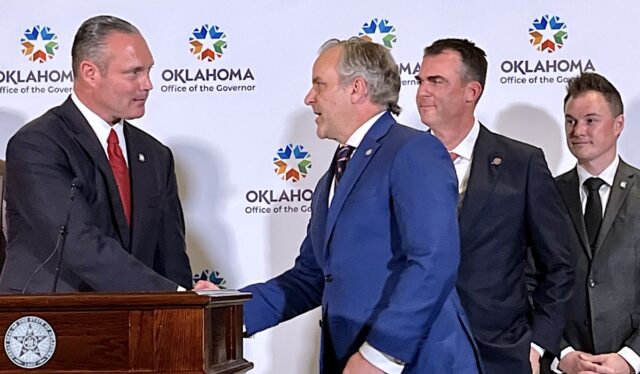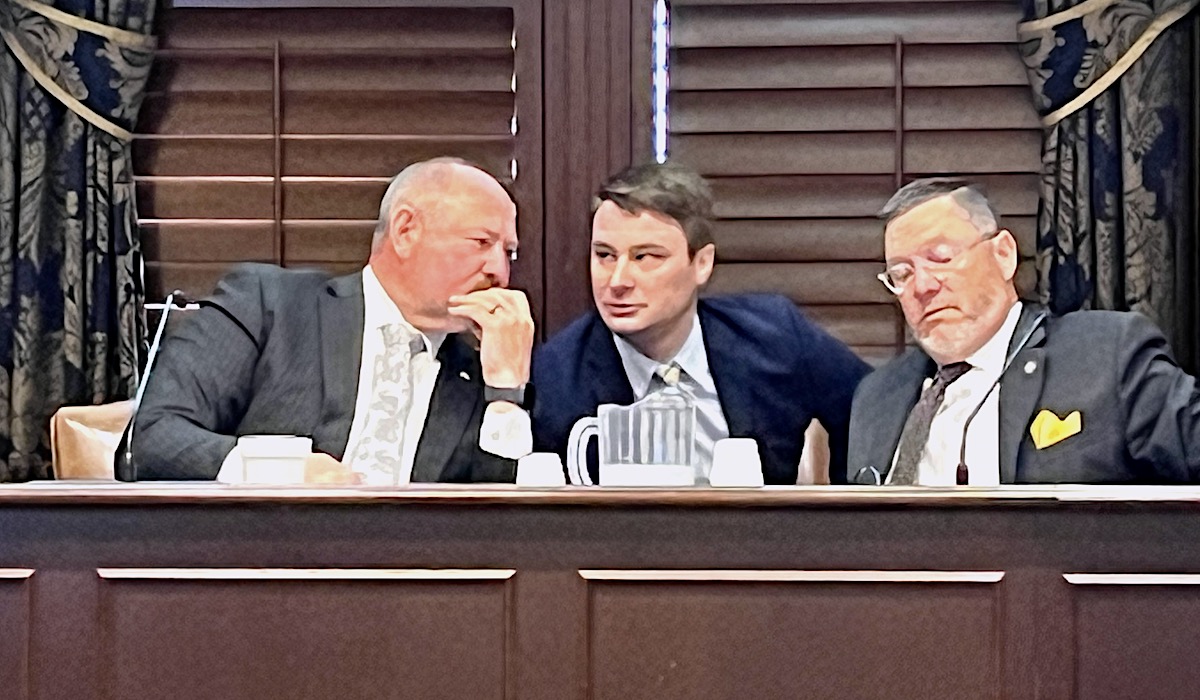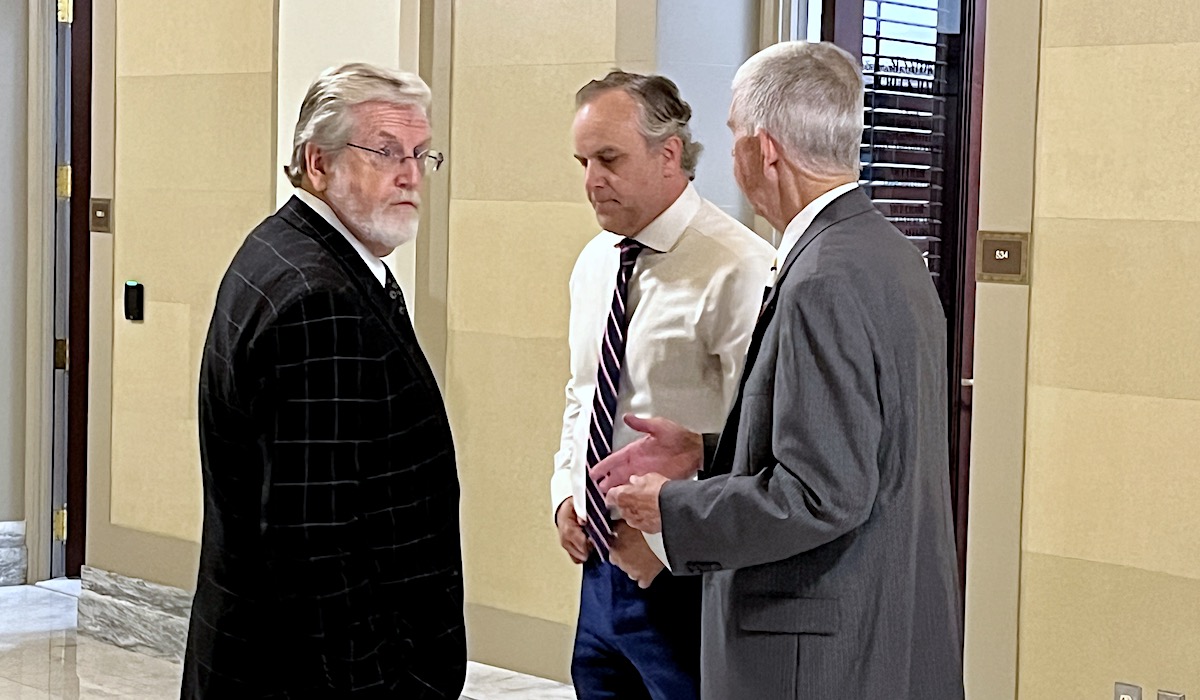

After a week of intense negotiations that included a former Supreme Court justice serving as a mediator, Republican leaders of the Oklahoma Legislature announced a grand agreement that will pump more than $625 million of additional dollars into public school districts, adjust the state funding formula to support smaller schools and raise teacher salaries statewide between $3,000 and $6,000.
According to House Speaker Charles McCall (R-Atoka), the historic education funding agreement will also cause him to send the governor HB 1934, a new refundable tax credit program for private school and homeschool families that the House had withheld from the governor’s desk despite voting to approve it May 2. That tax credit package has a payout cap of $150 million for its first year, which brings the total new allocation toward education closer to $800 million in a year where lawmakers have had about $1.2 billion in additional recurring revenue to allocate.
Monday’s announced agreement ends months of contentious back and forth between House and Senate leaders who have clashed over how best to allocate dollars to districts in urban, suburban and rural areas.
“There’s been a lot of great ideas this session and this truly is a compromise approach,” said McCall. “We’re excited for what it does for every student, every teacher and school and parent in the state, regardless of what their personal choice is in terms of educating that child.”
Expected to be written into bills that will move through Joint Committee on Appropriations and Budget meetings Tuesday, the public education portion of the package includes:
- About $286 million in new appropriations to fund teacher and certified school personnel pay raises of $3,000, $4,000, $5,000 and $6,000 — based on longevity — for all school districts, including those off of the formula;
- An additional $214 million of new appropriations into the state funding equalization formula. (Combined with the teacher pay component, $500 million in new appropriations will be put through the formula);
- Three modifications for the state funding formula that would compensate for bus transportation, support schools with higher percentages of socio-economically disadvantaged students, and create greater eligibility for the “small school” formula weight to increase funding for hundreds of rural schools;
- A total of $125 million of funding for next fiscal year in the Redbud Fund, which was created in 2021 to address property tax revenue disparities in districts with lower ad valorem bases;
- A $3.3 million-per-year, three-year pilot program for elementary school reading specialists;
- A commitment to provide six weeks of paid maternity leave for school employees.
In addition, the education deal includes an agreement for a one-time $150 million allocation in support of a three-year pilot program regarding school safety. With $50 million available for three years, the program would provide flexibility for districts to hire additional school resource officers (SROs) and make other investments toward safety measures, and it would provide $96,000 to each public school district for three years.
Stitt praised legislative leaders and said he was “proud to get this across the finish line for Oklahomans.”
“We’re in a great situation. I mean, what year could we stand up here and put an extra $625 million into public education? It’s because we have been fiscally disciplined over the last four years that we are even able to do this,” Stitt said. “We are all up here together really just planting the flag and saying, ‘Oklahoma is a place to be. Oklahoma is open to business.’ We know this is going to be attractive to other people around the country to move to Oklahoma.”
As announced, the education deal includes a provision stipulating that if public school funding is ever reduced, an equal percentage reduction would be applied to the school choice tax credits. In addition, lawmakers committed to providing additional funds for teacher pay raises at the Oklahoma School for the Blind (Muskogee) and the Oklahoma School for the Deaf (Sulphur), which are operated by the Department of Rehabilitation Services. Educators at the Department of Corrections and the Office of Juvenile Affairs will also receive pay raises, as will some CareerTech employees who are embedded within a public school district program.
Unpacking the Redbud Fund and its effect

Monday’s announcement concludes three months of intense negotiations that, at times, seemed destined to implode. Most cumbersome were the conversations about how best to support rural areas whose families are less likely to benefit from the new private school tax credit program championed under the mantra of “school choice.”
The House proposed a $300 million pot of money called the “Oklahoma Student Fund,” which would have appropriated dollars to schools outside the guidelines of the state funding equalization formula, disproportionately benefiting rural districts in per-pupil funding. The Senate balked at the formula-busting proposal, even as Stitt sided with the House and tried to strong-arm senators into supporting it.
After Stitt, McCall and Treat agreed to bring former Oklahoma Supreme Court Justice Steven Taylor into negotiations as a mediator, the House ultimately gave up its fight for the “Student Fund” around the same time Senate Democrats questioned the proposal’s constitutionality and said it would be challenged in court. It’s unclear whether Taylor offered his thoughts on the constitutional questions of the Student Fund proposal.
Ultimately, the House and Senate agreed to put most of the new education funding through the existing state formula, with tweaks to three weight factors aimed at supporting districts that have longer bus routes, districts that have lower-income populations and districts that have fewer students than urban and suburban schools.
In addition, negotiations found common ground to expand the complicated “Redbud Fund,” which was created in 2021 with medical marijuana tax revenues dedicated to support greater equalization of building fund revenues that come from property taxes. At the time, the bill helped lawmakers address a funding disparity for charter schools that had drawn a massive lawsuit, and it also provided additional assistance for hundreds of school districts with lower property tax bases than the state median.
For Fiscal Year 2023 — which ends June 30 of this year — data indicate that 308 school districts and 23 charter school districts received some money from the Redbud Fund. For this year, the additional funding equated to $367-per-child for charter schools, which are public schools that do not receive property tax revenues. Traditional school districts received the same figure per student, minus whatever amount is representative of the district’s building fund balance divided per student.
With the new funding and associated tweaks to the Redbud Fund’s language, about 100 additional districts — for a total of about 78 percent statewide — will receive money from the fund, with the baseline jumping from $367-per-student to about $530-per-student, according to early estimates and background conversations about the agreement.
In the end, it was ultimately the $150 million allocation for “school safety” that will provide the disproportionate support for rural districts that many House members wanted. With the program providing $96,000 per district to about 520 public school districts, rural districts with one school location will benefit more than urban districts with a dozen school sites.
Follow @NonDocMedia on:
Background on education deal negotiations

The months-long education stalemate brought the Legislature right to the edge of its constitutionally mandated budget precipice of May 26. With Treat and McCall trading barbs in competing press conferences May 4, the Stitt administration came up with a suggestion: find a mediator to help bring the sides together.
While Stitt gave credit to Secretary of State Office attorney Jeffrey Cartmell for the idea of bringing former Oklahoma Supreme Court Justice Steven Taylor in to mediate, the governor thanked the McAlester attorney for his free labor and joked that he needs to buy him a gift card to Pete’s Place.
“He’s a great Oklahoman, and we all know and respect Justice Taylor. Everybody in this building has a lot of respect for him,” Stitt said. “So we reached out to him and said, ‘Hey, if you don’t mind, come to the Governor’s Mansion on Monday (May 8).'”
Reflecting on the process — which included a white board, long hours of weekend phone calls and shuttle diplomacy via the stairwell at the Governor’s Mansion — Taylor provided his own perspective on the experience.
“When the governor asked me to serve as mediator, I knew it would be an interesting experience, and it truly has been,” said Taylor, who attended both GOP caucuses Monday as final details were presented. “This has been a respectful and detailed week-long process. Every part of this agreement has been vigorously discussed. The process was fair. The winners are K-12 students all over Oklahoma.”
Treat and other lawmakers involved sang Taylor’s praises as the negotiations continued, and his mediation played a large part in bringing about the conclusion of the education rigmarole.
During Monday’s announcement, Treat called Taylor “a true godsend to this process.”
“To be honest with you, Justice Taylor, when you started talking I didn’t think we’d be here a week from your comments declaring that we got a deal,” Treat said. “So thank you, for all of your time. You’re a true statesman.”
House Republicans began the saga Feb. 16 when they advanced two bills that would put $500 million in new funding toward Oklahoma public schools and create a school choice refundable tax credit, allowing families to get refunds on their taxes if they sent their kids to private schools or homeschooled them. (The $500 million included the $300 million in the proposed “Student Fund.”)
On March 9, McCall instructed the Senate not amend the two bills, annoying Treat, who called the demand “asinine.” Less than three weeks later, senators amended both bills and sent them back to the House anyway.
But McCall doubled down on his ultimatum March 28, and House Republicans eventually stripped the Senate amendments. After the Oklahoma Student Fund emerged as a major sticking point between the House and Senate, negotiations largely continued behind closed doors.
A compromise plan floated by Stitt on April 21 left the OSF intact, which gave Treat the impression his chamber was facing a House united with the governor in the education battle.
That impression was bolstered after Stitt vetoed 20 unrelated Senate bills six days later, with his veto message for all of them reading, in part, “I cannot, in good faith, allow another year to go by without cutting taxes and reforming education.”
The next day, April 27, Senators advanced an education package alternative, decoupling the funding bill from the tax credit bill.
House Republicans passed the Senate version of the school choice tax credits May 2 but kept it from being sent to the governor to maintain leverage for the OSF.
But after a week of intense negotiations last week and input from rank-and-file GOP legislators, House and Senate leadership and Stitt finally reached a compromise that includes aspects of House and Senate education priorities.
The passage of the public education funding deal will also unlock new refundable tax credits for private or homeschool families.
After the Senate advanced the tax credit bill, HB 1934, the House also advanced it but withheld it from the governor’s desk to maintain leverage in the public education funding negotiations. McCall said Monday that he intends to send it to Stitt following the passage of the public education funding package.
“We’ll decide as a caucus procedurally how we advance that bill to the governor. We have some options there,” McCall said. “At this time, we are committed to moving that to the governor.”
If it becomes law, the bill would create a $1,000-per-student credit for homeschool families and a tiered tax credit — between $7,500-per-student for families earning $75,000 or less and $5,000-per-student for families earning more than $250,000 — for private school families.
Families could be able to take advantage of the tax credit for the 2023-2024 school year.
The tax credit program for private school students would have a total cost cap of $150 million in its first year, and lower-income families will be prioritized. The total cost cap will increase to $200 million in its second year and $250 million in its third and subsequent years.
The homeschool tax credit program would have a total cost cap of $5 million.
Similar school choice expansion proposals — such as vouchers or education savings accounts (ESAs) — have advanced in legislatures across the country. Fewer than half of states allow anyone to use state funds to pay for a private education, however, and rural House Republicans in Texas just defeated a voucher proposal championed by Gov. Greg Abbot.
One day later, education bills revealed, moved through JCAB
On Tuesday, one day after the education deal was announced, legislators unveiled and advanced eight bills in their Joint Committees on Appropriations and Budget regarding the education package:
- HB 2901 appropriates $500 million additional funding to the education equalization formula, as well as $125 million additional funding to the Redbud Fund;
- HB 2902 adjusts weights in the state education equalization funding formula related to bus transportation, socio-economic status and school size;
- HB 2903 creates a three-year pilot program on school resource officers (SROs). With $50 million available each of the three years, all 517 school districts with physical locations will receive an equal disbursement of $96,000 per district, regardless of enrollment size or school site count;
- HB 2904 puts $150 million aside for implementation of the SRO program in HB 2903;
- SB 1118 appropriates $10 million to the State Board of Education for a three-year pilot program to create a literary instruction team;
- SB 1119 raises the minimum salary schedule for certified personnel in public schools. The raise is between $3,000 and $6,000 depending on longevity;
- SB 1120 modifies the caps and parameters for the Redbud Fund, which attempts to equalize building fund amounts available to school districts otherwise derived from property taxes;
- SB 1121 establishes six weeks of paid maternity leave for full-time public school district employees who have worked at the district for at least one year.
Another 13 bills also moved through the JCAB process Tuesday, primarily appropriating federal American Rescue Plan Act funds and extending the expiration dates on a pair of state-tribal compacts:
- HB 2898 extends the state’s existing tribal compact language on tobacco sales taxes through Jan. 1, 2028;
- HB 2899 extends the state’s existing tribal compact language on motor-license vehicle registration through Jan. 1, 2028;
- HB 2940 creates a fund for $5.8 million future Office of Management and Enterprise Services costs associated with ARPA administration;
- HB 2941 appropriates $10 million of ARPA funding to the Oklahoma Arts Council and creates parameters for its use;
- HB 2942 appropriates funds to the Oklahoma Water Resources Board;
- HB 2943 appropriates $4 million to the State Department of Health for a new Ronald McDonald House at Mercy Hospital and $2 million to the Bethany Children’s Hospital;
- HB 2944 appropriates $4.7 million for ARPA administration costs at the Office of Management and Enterprise Services;
- HB 2945 appropriates $481,000 of ARPA funding to the Legislative Service Bureau;
- SB 1186 appropriates $12.8 million of ARPA funding to the Department of Human Services to create a food assistance grant program;
- SB 1187 appropriates $600,000 of ARPA funding to the Oklahoma Aeronautics Commission to support air and space museums affected by the pandemic;
- SB 1188 appropriates ARPA funding to the Health Care Workforce Training Commission to fund nursing program expansions at Northeastern Oklahoma Agricultural and Mechanical College ($1.3 million), Rogers State University ($1.25 million), East Central University ($7 million). The bill appropriates additional money for previously approved ARPA projects, including the pharmacy program expansion at Southwestern Oklahoma Student University ($5 million), expansion of the optometry program at Northeastern Oklahoma State University ($3 million) and expansion of a health care program at Southeastern Oklahoma State University ($1 million);
- SB 1189 appropriates more than $18.4 million of ARPA funding to the Department of Mental Health and Substance Abuse Services for the Tulsa Center for Behavioral Health;
- SB 1190 appropriates $4.4 million of ARPA funding to the Military Department for the National Guard’s first responder center and joint operations center.
(Update: This article was updated at 2:30 p.m. Tuesday, May 16, to include descriptions of all bills unveiled and advanced through the JCAB process that day.)




















